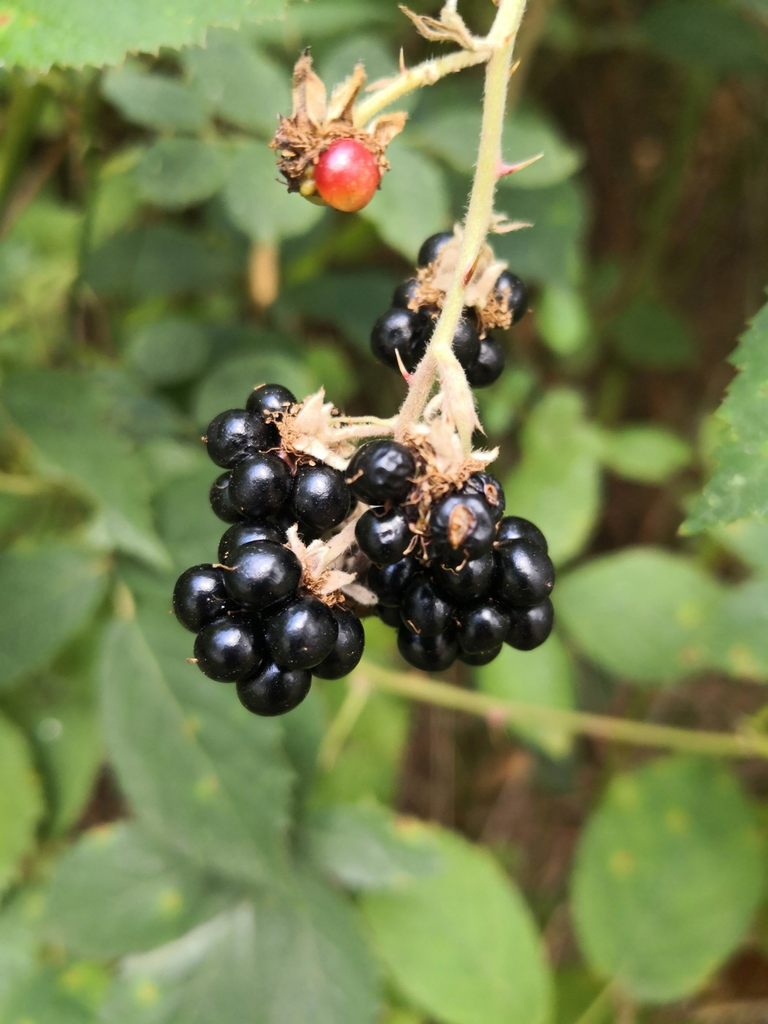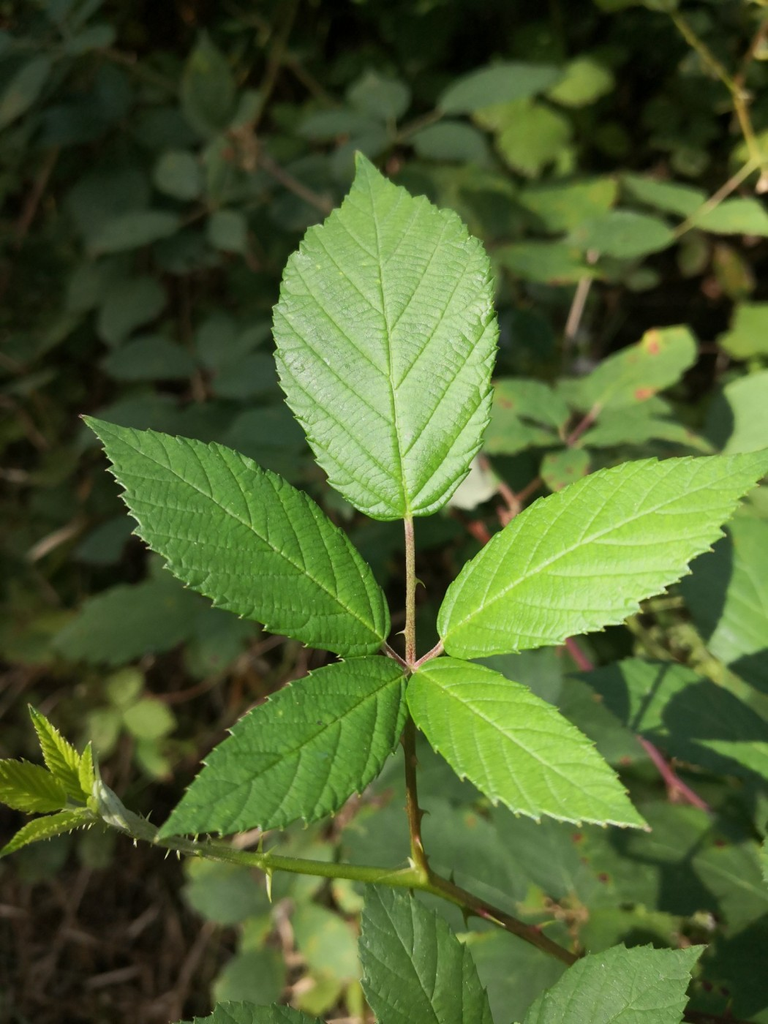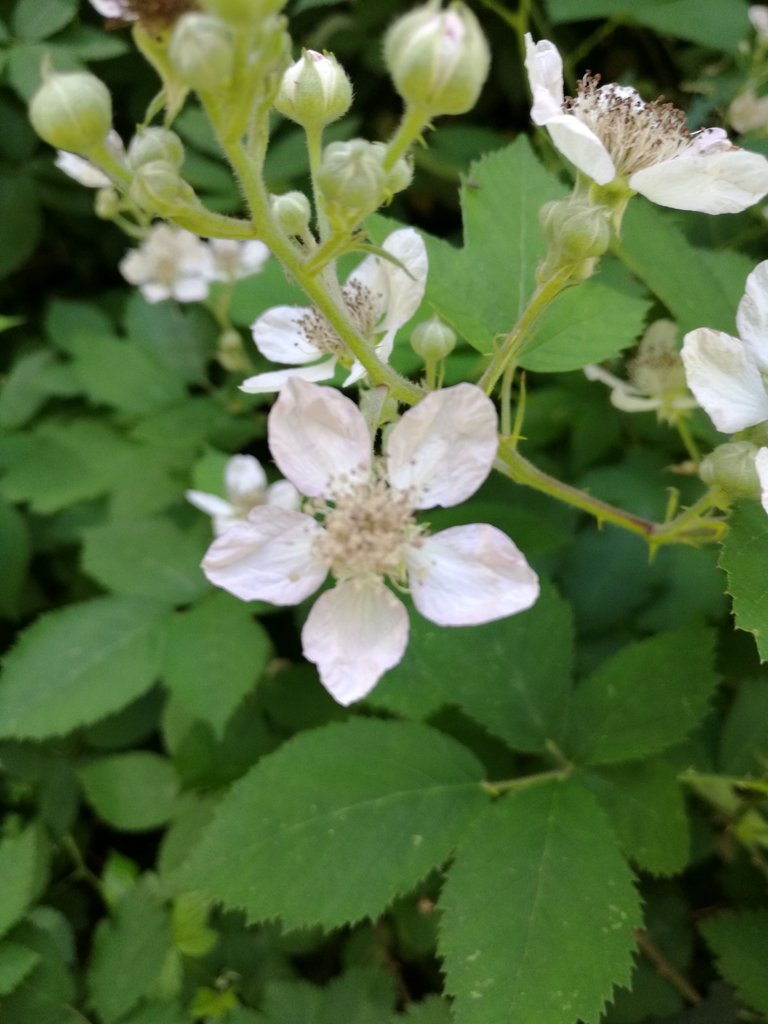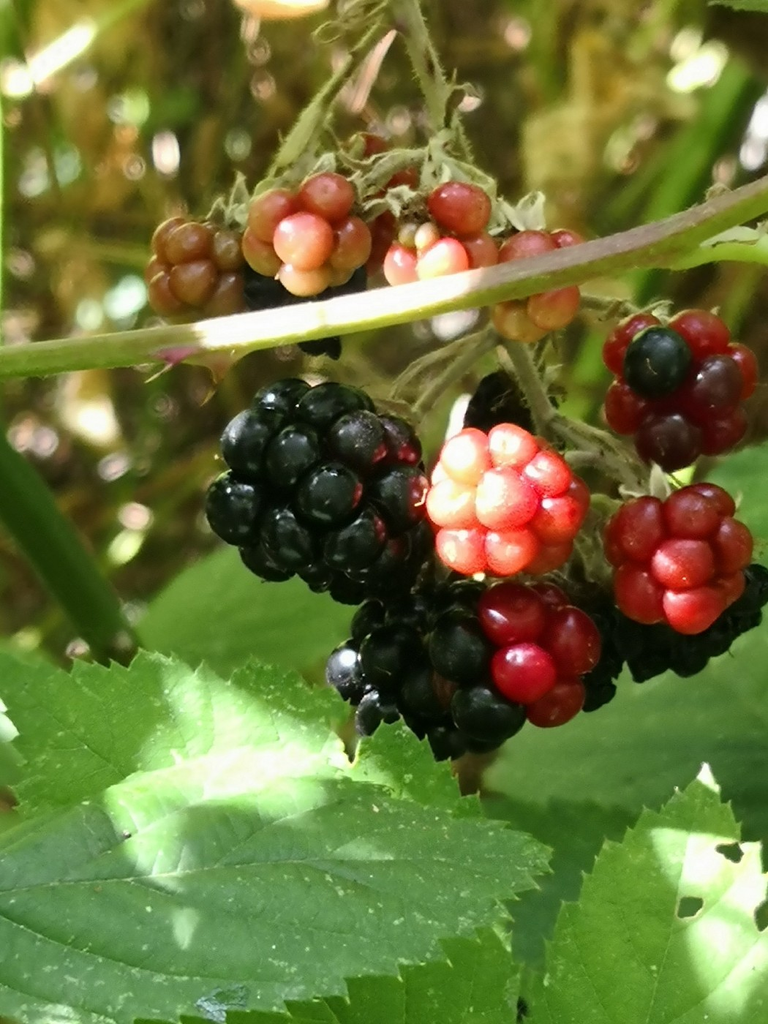Blackberry (Rubus fruticosus and others)

Here's the next in our huge update of our Ligaya Garden Online kitchen herbalism pages. This one's delicious Blackberries.
.
Common names: Blackberry, European Blackberry, Bramble
Taxonomic name: Rubus fruticosus and others
Family: Rosaceae
Related herbs: Roses, Wild Roses, Peach, Almond
Area of origin: Europe, North Africa, North America, Asia
Parts used: leaves, berries (ripe and unripe)
Can be used for: Food, stomach complaints, diarrhoea
Actions: Astringent, vulnerary; fruits: blood tonic, nutritive, refrigerant
Taste: sweet astringent, sour, bitter
Tissue states: damp/stagnation, damp/relaxation, heat/excitation
Energetics: constricting, drying, cooling
Healing constituents: Leaves and root: tannins, ascorbic acid, hydroquinone, arbutin, malic acid; fruit: chlorogenic acid, malic acid, sugars, pectin, anthocyanins, vitamin A and C
Warnings: Prickly to harvest and so delicious that probably only half of what you pick will make it home!
Description
Perennial, scrambling, shrubby plant with long canes and lots of thorns. Leaves have 3 to 5 leaflets and are borne on prickly stalks. White or pale pink flowers with 5 sepals and petals and many stamen. Fleshy fruit changes from green through red to black as they ripen. They grow in dense, thorny patches that don’t want to let you go when you’re picking. They seem to have an evil intelligence too, ripening first the berries that are just beyond one’s reach, causing you to edge always further into the patch’s prickly embrace.


.
Medicinal use
All of the Rose family (Rosaceae) are slightly bitter, sour and cooling (I only discovered the joys of Peach leaf tea a couple of years ago and now, it’s a hot weather staple). Blackberry is no different. The sweet berries have a touch of sourness that is most appreciated in the hot weather when they are around. Too much though and the cooling effect can reach your stomach and bowels and cause diarrhoea, the very thing that Blackberry leaves are known for stopping.
Blackberries are well known for their delicious berries, they’re also full of vitamins C and K, manganese and both soluble and insoluble fibre that will help keep you regular. The vitamins and tannins in Blackberries make them useful for wound healing with the vitamin C helping fight infection while the tannins and vitamin K help with clotting. Blackberry leaves have a high concentration of tannins, which bind with proteins on mucosal surfaces, preventing fluid from leaking through.
Blackberry leaves heal external wounds when crushed and applied as a poultice or as a wash, Used this way, they are excellent at helping heal minor cuts and scrapes as their tannins coagulate proteins, locally, in the blood and close off leaking, damaged capillaries.
An infusion of Blackberry leaves can stop diarrhoea in its tracks. When the high levels of tannins in the leaves hit the intestinal lining, they cause it to tone and tighten reducing moisture loss through the leaky mucosa. Remember though that diarrhoea is a normal bodily response to an irritant in the lower digestive tract. It is the body’s way of flushing out what is causing problems. If diarrhoea lasts more than a day or so, though, that’s when we need to look upon it as being a problem. That and when it occurs just before a big night out. It can also be a part of our body’s response to an infection or fever as we try to flush out the accumulated toxins.
Diarrhoea can also come from anxiety and stress so if you’re prone to this kind of loose movement, a cup or two of Blackberry infusion before a big event can help get you through.
Other conditions caused by lax tissues are hemorrhoids, varicose veins, prolapse and Blackberry can help with these. The urinary tract too can suffer from leaky, lax tissues which can show up as frequent urination. They are listed in many sources as being of help with excessive menstruation, though I’ve not been called on to help with that issue yet. If I do, Blackberry leaves will definitely be amongst my arsenal.
All of these symptoms come under the rubric of ‘damp’ and after reading this, you can probably see why. Damp oozes and leaks if tissues and membranes aren’t tight and toned, which is exactly what Blackberry is best at fixing. Other things that you may think about using Blackberry leaves for are mouth ulcers, shingles and eczema, especially when the latter two are weeping.
If you want to think a bit more deeply about Blackberry, it’s all about barriers. From the formidable physical barrier of a bramble patch to the leaves’ effect on membranes and tissues that have lost their barrier status and are leaking things through.
Blackberry patches in Australia have become substitute homes for many small birds, reptiles and other critters now that a lot of the protective native bush has been cleared. In this way, they have become protective barriers that nurture the small things that live inside. Summer Blackberry leaves are loved by pollinators and in our local forest, you can see dozens of butterflies flying around near the patches.


Preparing and using
Blackberry harvesting is an exercise in mindfulness and great for the reflexes! Fresh berries are delicious and healthy for you and you can juice them too. Homemade Blackberry jam is a real treat that leaves the shop bought stuff wanting.
A syrup made from Blackberry and sugar is a wonderful way to ease colds, flu and sore throats all kinds of children, including husbands and other sufferers of ‘man flu’, which as we all know if far worse than any other kind of flu around! The soothing syrup and the vitamins in the berries work a treat. We don’t use syrups often here at Ligaya Garden as one of us is a diabetic, but try one, they are amazing.
Dry the leaves and use them make a strong infusion for diarrhoea and general ‘loose type stomach complaints. Fresh leaves work well too. I’ve never tried a tincture of blackberry leaves, as the goodies are all water soluble, so teas and infusions are the go. Use the infusion as a wash for external issues and a mouthwash for mouth ulcers and bleeding gums and for all kinds of woozing, weeping skin complaints. A fomentation or compress may also be made from the infusion if they are more convenient than a wash.
This year, I was unfortunate enough to get a UTI from not hydrating properly during the heat of Summer. I didn't have any astringent herbs ready except for Blackberry and a little remaining dried Plantain, so I tired a strong infusion of both. Most of the burning towards my bladder and prostate disappeared shortly after each cup drunk. It didn't clar it totally but the relief was, well...a relief!
Some of you may have seen that I've been writing a series of posts about herbs and making herbal remedies at home. I want to share what I know of this topic so that, as the world gets crazier, folks will have other avenues of medical care, namely those of themselves and their community. If you look back over this blog, you can see heaps of info on the topic, plus loads and loads of posts on herbs and using Australian bushfoods from a white perspective. If you haven't been around on in the @hivegarden and @naturalmedicine communities for long, you may be interested in looking back. There's w-a-a-a-a-y too much there for me to repost and the Hive system doesn't let you vote on old posts so, if you're happy with what you find, I believe that there is now a tip option...






Thanks for your contribution to the STEMsocial community. Feel free to join us on discord to get to know the rest of us!
Please consider delegating to the @stemsocial account (85% of the curation rewards are returned).
You may also include @stemsocial as a beneficiary of the rewards of this post to get a stronger support.
great post ! i love blackberry. I picked and dried a few leaves last year and then added kombucha and water kefir for the 2nd fermentation. It tastes very sweet.
However, I could only recognize it at that time when the fruits were still on. Otherwise, I often worry about confusing blackberry leaves with raspberry leaves or strawberry leaves. Blackberry leaves are white on the underside, aren't they? and the spines are slightly curved and can also be found on the underside of the leaf.
Strawberry leaves and stems are reddish, as far as I know.
I have also read that raspberry leaves and blackberry leaves are often confused in midwifery.
Raspberry leaves are supposedly there to keep the baby inside, so the tissue tightens. Now it is said that these properties are actually attributed to blackberry leaves... and that raspberry leaves could even lead to a miscarriage... I don't know myself.
best regards !